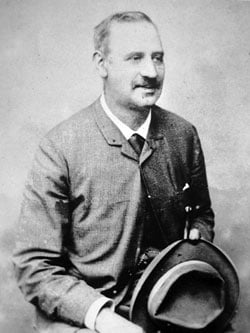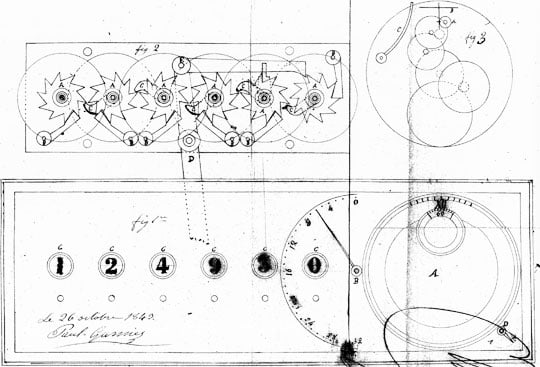Jean-Paul Garnier was a French mechanic and watchmaker. He won several awards for his watchmaking, with inventions including a free escapement and winding force and a precision regulator for astronomical data. However, he is also well-known for his role in providing every railway station in France with a station clock. He eventually gave his entire collection of watches and clocks to the Louvre Museum where an entire room is now dedicated in his honor.
Garnier also invented a mechanical calculating machine. This calculating machine was designed to work using a watch-like mechanism of dials. However, the machine no longer exists, and little else is known about it other than what is presented on the initial patent drawings.
Quick Facts
- Full Name
- Paul Garnier
- Children
- Virginie (1830-1912), Paul-Casimir (6 March 1834–13 July 1916)
- Nationality
- French
- Place of Birth
- France
- Fields of Expertise
- [“Inventor”]
- Contributions
- calculating machine
Read on to discover the full biography of Jean-Paul Garnier!
Who was Jean-Paul Garnier?

Jean-Paul Garnier was a brilliant French mechanic and watchmaker from the 19th century. He was best known for station clocks to railway stations in France and Romania. His passion, competence, and skill saw him rise to be among the famous watchmakers of the time and earned him multiple awards in watchmaking.
Early Life
Jean-Paul Garnier was born in a low-income family of musicians on 16 November 1801 in Épinal dans Les Vosges (the Lorraine region). Jean-Paul was forced to begin his professional career as a 10-year-old boy as an apprentice in a printing shop. He completed a locksmith apprenticeship in Épinal, and finally, he became a watchmaker apprentice in Luxeuil-Les-Bains.
Career
Jean-Paul Garnier’s career was focused on watchmaking. He worked to perfect his skills, making him grow into an independent watchmaker. Paul Garnier was a member of the French Society of Civil Engineers and Chevalier of the Legion of Honour.
Lépine Workshop
Garnier’s passion and competence for mechanics secured him a place in 1820 in the workshop of the famous watchmakers of the time—Lépine (Lépine, Philibert, and Jean-Antoine were also the creators of an early calculating machine, in Paris, then in the workshop the famous French clockmaker Antide Janvier (1751–1835). He started as an independent watchmaker five years later, setting up his workshop at Rue Taibout 8.
Besançon Universal Timepiece Exhibition.
Jean-Paul Garnier was a jury member at the Besançon Universal Timepiece Exhibition. In 1861, he was chosen by the French government to make proposals for the development and influence of the watch industry.
What Was Jean-Paul Garnier Known For?

Watchmaking
Paul Garnier was one of the most skillful masters of his time in electric clocks (he first applied electric transmission to clocks in France in 1847. In 1851, he received a gold medal at the Great Exhibition in London) and had numerous inventions in the field of watchmaking. Some of these include:
- Free escapement and winding constant force (presented to the Academy of Sciences in 1826)
- Precision regulator to astronomical data (presented at the Universal Exhibition of Besançon)
- Sphygmometer (an instrument used to view the human eye movement of arterial blood)
- Travel clocks or cars accessible to everyone
- Revolution’s counter
- A device that indicates the exact time of passage of the train station
He was also famous for providing all stations in France with station clocks. He gave his entire collection of watches and clocks to the Louvre Museum, where a room is now named after Paul Garnier.
Mechanical Calculating Machine
In 1843 Paul Garnier obtained a 6-year patent ( Brevet d’invention No. 15915) for a computer (see the lower patent drawing). The device seems to have a simple and reliable construction and a watch-like result mechanism (dials). Unfortunately, besides the patent description, nothing else is known about the machine.

Jean-Paul Garnier: Marriage, Children, and Personal Life
Marriage & Children
Paul Garnier was married to Mélanie Abel Duval, and they had a daughter–Virginie (1830-1912), and a son — Paul-Casimir (6 March 1834–13 July 1916). Paul-Casimir Garnier was an engineer and Officier de la légion d’honneur, worked in his father’s business, and later became his successor with his nephew Paul-Pierre Blot-Garnier (1871-1938). Jean-Paul Garnier died in Paris on 14 February 1869 and was buried at Cimetière du Père-Lachaise.
Jean-Paul Garnier: Awards and Achievements
Because of his watchmaking expertise, Paul Garnier received many medals at world exhibitions, including his work on electromagnetic telegraph clocks. He also received a gold medal in the Great Exhibition in London.
